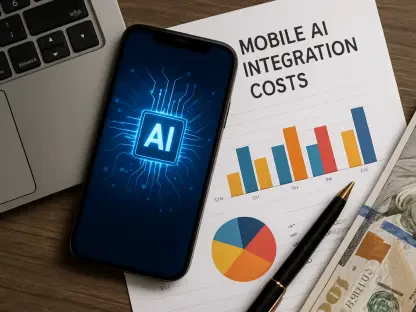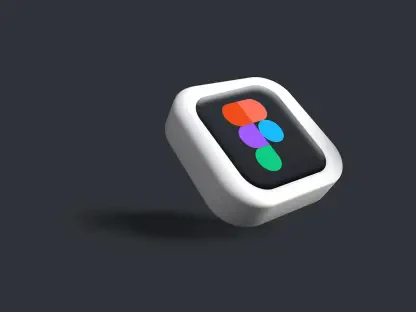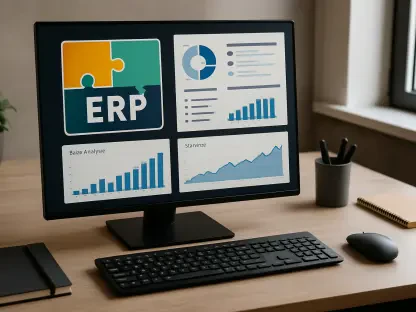Setting the Stage for a Digital Revolution
In an era where mobile devices are ubiquitous, the Android ecosystem stands as a colossus, powering billions of devices and hosting over 3.5 million apps on the Google Play Store. This vast platform has become a battleground for innovation, with developers racing to deliver applications that are faster, more reliable, and feature-rich to meet escalating user demands. Amid this competitive frenzy, cloud technology has emerged as a transformative force, redefining the very fabric of Android app development. Far beyond simple storage solutions, cloud infrastructure offers unparalleled computing power, real-time data synchronization, and scalability that traditional methods struggle to match. This shift is not just a trend but a fundamental change, positioning cloud integration as a cornerstone for creating cutting-edge mobile experiences.
The current state of the industry reveals a pressing need for solutions that can handle the complexities of modern app requirements. Developers face challenges like limited device hardware, fluctuating user loads, and the necessity for seamless cross-device functionality. Cloud technology, backed by giants such as Google Cloud, Amazon Web Services (AWS), and Microsoft Azure, provides the tools to overcome these hurdles, enabling even resource-constrained devices to run sophisticated applications. As the mobile app market continues to grow, understanding the role of cloud solutions becomes essential for businesses and developers aiming to stay ahead in this dynamic landscape.
Key Impacts of Cloud Technology on Android Development
Enhancing Scalability and Performance
Cloud technology addresses one of the most persistent challenges in Android app development: ensuring consistent performance across diverse devices. By offloading resource-intensive tasks to remote servers, apps can function smoothly on low-end hardware, democratizing access to advanced features. This capability is crucial for reaching a global audience, where device capabilities vary widely, ensuring that users experience the same quality regardless of their hardware limitations.
Moreover, cloud infrastructure offers dynamic scalability, allowing apps to adapt to sudden spikes in user activity without crashing or slowing down. Unlike traditional scaling methods that require significant upfront investment in physical servers, cloud solutions automatically adjust resources based on demand. Streaming services like Netflix and Spotify exemplify this benefit, maintaining high availability during peak usage periods, such as major content releases or live events, without compromising user experience.
This scalability also translates into enhanced stability, reducing downtime and ensuring reliability. For developers, this means fewer concerns about infrastructure bottlenecks and more focus on crafting engaging features. The ability to handle varying loads efficiently marks a significant departure from past constraints, positioning cloud technology as a vital component in modern app architecture.
Driving Efficiency and Cost-Effectiveness
Beyond performance, cloud technology brings substantial operational advantages to Android app development. The pay-as-you-go pricing model of cloud services eliminates the need for costly upfront investments in server hardware, a boon for startups and small to medium-sized enterprises (SMEs) with limited budgets. This financial flexibility allows smaller players to compete with industry giants by accessing top-tier infrastructure at a fraction of the cost.
Additionally, cloud solutions reduce the burden of backend management, freeing developers from routine maintenance tasks. With less dependency on local device storage, apps can offer expansive features without overloading users’ phones, streamlining the development process. This efficiency enables teams to prioritize innovation, experimenting with new functionalities instead of wrestling with infrastructure challenges.
The impact of these efficiencies extends to faster time-to-market for new apps and updates. By leveraging cloud resources, developers can iterate quickly, test features in real-world scenarios, and deploy enhancements without delays caused by hardware limitations. This agility is a critical asset in a market where user expectations evolve rapidly, underscoring the strategic value of cloud adoption.
Challenges in Adopting Cloud Technology for Android Apps
Integrating cloud solutions into Android development is not without obstacles, particularly in technical implementation. Optimizing data transfer between devices and cloud servers remains a complex task, as developers must balance speed with battery efficiency to avoid draining user resources. Ensuring offline functionality is another hurdle, as apps need to maintain core features during connectivity disruptions, requiring sophisticated caching and synchronization strategies.
Security concerns also loom large, especially for apps in sensitive sectors like finance, healthcare, and e-commerce. Protecting user data against breaches and ensuring privacy in a cloud environment demand robust measures such as end-to-end encryption and secure API communications. Developers must navigate these risks carefully, as a single vulnerability can erode user trust and damage brand reputation.
Mitigating these challenges involves adopting best practices and partnering with reliable cloud providers that prioritize security and performance. Implementing thorough testing for offline scenarios and investing in threat monitoring can further reduce risks. While these hurdles require effort, they are surmountable with the right expertise and tools, paving the way for successful cloud integration.
Security and Compliance in Cloud-Based Android Development
The importance of security in cloud-powered Android apps cannot be overstated, given the sensitive nature of data handled by many applications. Encryption, strong authentication protocols, and continuous monitoring are essential to safeguard information against unauthorized access and cyber threats. These measures are particularly critical for industries where data breaches can have severe legal and financial repercussions.
Compliance with regulatory standards adds another layer of complexity to cloud integration. Apps dealing with personal or financial information must adhere to strict guidelines, such as those set by global data protection laws, to avoid penalties and maintain credibility. Cloud providers and developers must collaborate closely to ensure that infrastructure and app design align with these requirements, embedding compliance into every stage of development.
Building user trust hinges on these security and compliance efforts. Transparent data handling practices and a visible commitment to protecting user privacy can differentiate an app in a crowded market. As cyber threats evolve, staying ahead with updated security protocols and fostering a culture of accountability between developers and cloud providers remains paramount for long-term success.
Future Trends and Innovations in Cloud-Powered Android Apps
Looking ahead, the convergence of cloud technology with emerging fields like artificial intelligence (AI), Internet of Things (IoT), and edge computing promises to redefine Android app capabilities. AI integration through cloud-hosted machine learning models enables personalized user experiences, from tailored recommendations to predictive functionalities, enhancing engagement across various app categories.
IoT and edge computing further expand possibilities by facilitating real-time device control and reducing latency through localized data processing. This synergy allows Android apps to power smart home systems, wearable devices, and industrial automation with unprecedented responsiveness. Such innovations cater to growing user expectations for seamless, adaptive interactions in an increasingly connected world.
Market dynamics also play a role in shaping these trends, as global economic factors and technological advancements drive demand for accessible, intelligent applications. Developers who embrace these integrations can position themselves as pioneers, creating apps that not only meet current needs but also anticipate future shifts. Staying competitive in this space will require continuous investment in research and adaptation to emerging cloud-driven paradigms.
Reflecting on Insights and Next Steps
Looking back, the exploration of cloud technology’s role in Android app development revealed a landscape transformed by scalability, efficiency, and innovation. The ability to offload complex tasks, manage costs effectively, and integrate cutting-edge technologies stood out as game-changing benefits that reshaped industry standards. Security and compliance emerged as critical focus areas, demanding rigorous attention to protect user trust and meet regulatory demands.
For developers and businesses, the path forward involves actionable strategies to harness these insights. Partnering with experienced cloud service providers and investing in specialized talent proves essential to navigate technical and security challenges effectively. Prioritizing user-centric design while leveraging AI and IoT integrations offers a way to anticipate evolving expectations and deliver standout applications.
As the industry moves forward, fostering collaboration between stakeholders becomes a key consideration. Encouraging knowledge-sharing and adopting agile methodologies helps teams stay responsive to rapid technological changes. By focusing on these steps, the Android development community positions itself to capitalize on cloud technology’s potential, driving growth and innovation in a competitive digital ecosystem.









